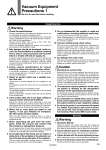
m-03-3c-seihin_en 38 / 77
10秒後にBOOKのページに移動します
Design/Selection Caution 1. Mounting the suction filter Because the suction of vacuum equipment acts not only on workpieces but also on dust or water droplets in the surrounding atmosphere, steps must be taken to prevent their penetration into the equipment’s interior. Even when using equipment equipped with filters, if there is a considerable amount of dust in the environment, use a separately ordered large-size filter as well. If there is a possibility of water droplets being sucked in by the vacuum, use a drain separator for vacuum. 2. The maximum vacuum pressure of the vacuum ejector is affected by the atmospheric pressure of the operating environment. As atmospheric pressure changes based on altitude, climate, etc., the actual maximum vacuum pressure may not reach the value listed in the specifications. 3. For information on related items, such as directional control equipment and actuators, refer to the caution sections in each respective catalog. 4. Do not use the product in an environment that exposes it to vibration. If the product is used in such an environment, we can offer a lock nut type product to prevent it from loosening. Please contact SMC for part number. Mounting Warning 10. Vacuum holding using check valves SMC can issue no guarantees regarding the maintenance of workpiece adsorption when using check valves. Take separate safety measures to prevent workpieces from dropping in the case of an electrical power outage, etc. Please consult with SMC when using check valves as a means of preventing interference caused by the exhaust from nearby ejectors. 11. Air leakage from main valve SMC does not guarantee that no air leaks from the main valve used for the vacuum ejector/vacuum pump system. If air leakage is a problem, please contact SMC. Vacuum Equipment Precautions 1 Be sure to read this before handling. Warning 1. Check the specifications. Products represented in this catalog are designed only for use in compressed air systems (including vacuum). Do not operate at pressures or temperatures, etc., beyond the range of specifications, as this can cause damage or malfunction. (Refer to the specifications.) Please contact SMC when using a fluid other than compressed air (including vacuum). We do not guarantee against any damage if the product is used outside of the specification range. 2. Safe designs should be developed, which account for the possibility of accidents resulting from a drop in vacuum pressure due to power failure or trouble with the air supply, etc. If vacuum pressure drops and there is a loss of vacuum pad adsorption force, workpieces being carried may fall, causing human injury or damage to machinery. Sufficient safety measures should be implemented, such as drop prevention, to avoid any accidents. 3. Follow vacuum specifications for vacuum switching valves and vacuum release valves. If non-vacuum equipment is installed in a vacuum piping, vacuum leakage will occur. Therefore, select only equipment for vacuum specifications. 4. Select an ejector which has a suitable suction flow rate.